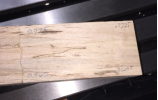Ok .... broke away for a couple minutes....
I got the Little Machine Shop ("LMS") High Torque Mini Mill (which I see is not in stock just now..... :-( ). I was originally thinking of the harbor freight mini mill .... but the coupon for the thing at $599 or so became invalid, and it did not look like they were going to issue another, so the price of the thing became $799. I have been forewarned that both the HF mill and and LMS SIEG mill used plastic gears between the motor and t he shaft .... and that these break. The solutin is to get a belt and pully conversion .... which is something like $150 .... so that starts pushing the actual cost of one of the "lesser" mills closer to the price for the LMS Hi torque mini mill (which is direct drive with a brushless motor ... and thus continuously variable from very low rpm to its highest setting). It also has a more solid column... So I just decided to go with the better mill, and save the headaches of the pully conversion.
The thing is HEAVY (~127 pounds), but is rock solid. It is also basically whisper quiet. I did a couple test millings of handle/scale material, and even without leveling the table, across the scale the thickness was within 0.005" or so. Mill that out to wanted dimension/thickness, take a quick pass by hand on 60 grit sandpaper, and a scale is ready for glue-up. As others have warned, the surface is NOT a machine-like metal surface, but can have some pull-outs. I dont care about this.... as you need to roughen the surface for glueing anyway .... and if the pull outs are on the sides of the scale, well, they are limited in size, and if you make the scale slightly oversize in the length and width, those sections get cut/sanded out anyway when you fit to the handle.
I've recently been working on a Wa handle, and have a couple definite observations:
* if you want to side-mill to create a side perpendicular to a face, you need an oversize/longer end mill, otherwise you can not mill the entire face without bottoming out the collet onto the top surface.
*I had to do some back-and-forth between the drill chuck and the collet (actually I am using an end mill holder). This is kind of a pain, but not doable, and worth it for the rock-solid drilling accuracy.
*the mill does NOT have the same vertical clearance capability as a drill press. So .... when I went to drill out the central hole in my Wa handle stock, I could not place the wood stock vertically on the top section of my vise. I got around this by clamping the wood on the side of the vise so that a bunch of the handle actually sat below the bottom level of the vise .... but I could make it happen.
*BUT, when it came to drilling out the dowel after glue up .... there is no way at all that I could fit my extra long 1/8" drill into t he mill. So I did a couple shallow drill holes with a short 1/8" drill bit in the mill, then want to my bench vise with a hand drill and the long drill bit to complete the drilling into the depth of the wa handle. (this would not be an issue with standard scales)
*it was also a pleasure to be able to mill out the small slot in the front of the bolster for the Wa handle, instead of drilling holes by hand and then using a file to fill out the opening...
That might be TMI for you .... but so far I love the mill. No regrets....


